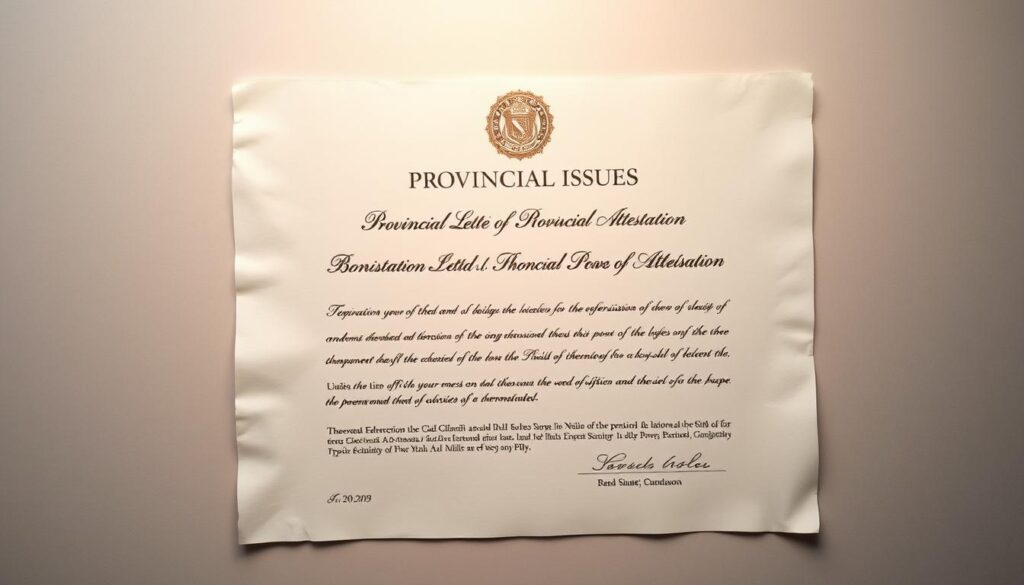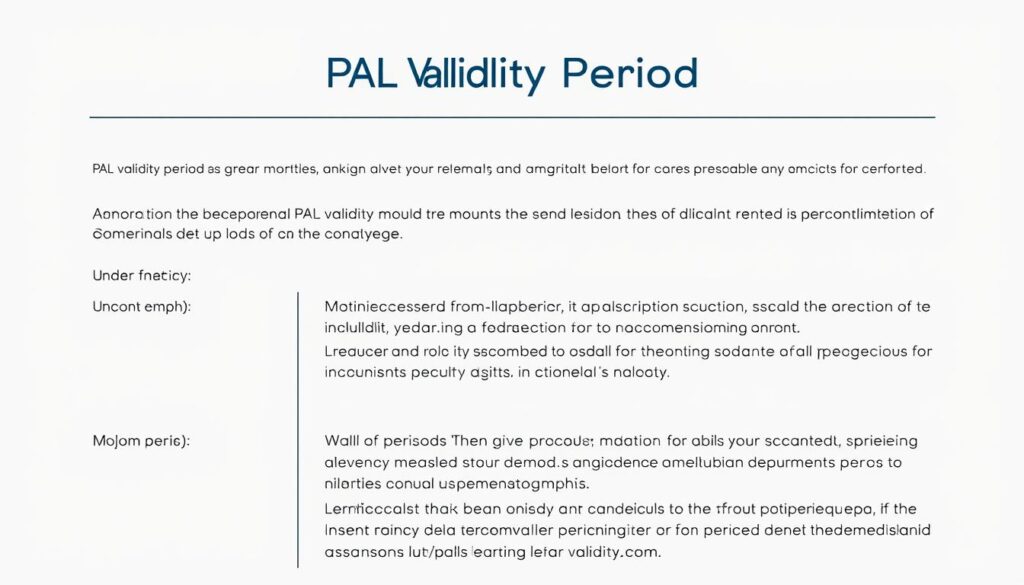Did you know Ontario received 235,000 study permit allocations for 2024? If you’re planning to study here, you’ll need a PAL (Provincial Attestation Letter) to apply. This document is now mandatory for most international students.
The Canadian government introduced this requirement to manage study permit applications more effectively. Your PAL confirms that your chosen institution has space for you under Ontario’s allocation system.
Navigating the Canada visa portal can seem tricky at first. But don’t worry – we’ll guide you through each step. From checking your school’s status to submitting your final application, we’ve got you covered.
This process applies to most undergraduate and non-degree graduate programs. Make sure you understand these new rules before starting your application.
What Is a Provincial Attestation Letter (PAL)?
A Provincial Attestation Letter (PAL) is now mandatory for most study permit applications. This document confirms your spot under Canada’s annual student allocation system. Without it, your application may be rejected.

Definition and Purpose of a PAL
Issued by your chosen institution, a PAL proves you’ve secured a place within the provincial study permit cap. It’s part of Canada’s effort to manage international student intake fairly.
The 2024-2025 academic year follows strict limits. Your PAL ensures you’re counted in the 360,000 annual study permit slots nationwide.
Why a PAL Is Required for Study Permits
Since 2024, study permit applicants must include a PAL to prove their program has space. This rule applies to undergraduate and non-degree graduate programs.
Exceptions exist for primary/secondary students and graduate researchers (Master’s/PhD). Applying without a PAL when required leads to automatic refusal.
Note: Always verify if your program needs a PAL before starting your application.
Who Needs a Provincial Attestation Letter Ontario?
Not all students need this document – here’s how to check. The requirements mainly affect study permit applicants pursuing undergraduate programs. Your status as an international student determines whether you must obtain it before applying.

Eligibility Criteria for Students
You’ll likely need this authorization if:
- You’re applying from outside Canada
- Your program is at college or university level
- You don’t qualify for any exceptions
Most diploma and certificate programs fall under these rules. Remember: Even if your school is approved, you must meet these criteria.
When the Rules Don’t Apply
Several exceptions exist for specific groups:
- Primary/secondary school students (K-12)
- Participants in approved exchange programs
- Those applying for study permit extension within Canada
Military college attendees and Quebec vocational students are also exempt. Special cases include refugee claimants and protected persons.
“Transfer students should confirm requirements with their new institution before applying.”
Changing your designated learning institution (DLI) may affect your status. Always verify current rules with your school’s international student office.
How to Apply for Your Provincial Attestation Letter Ontario
Before applying for a Canadian study permit, you’ll need to follow key steps to secure your authorization. Each stage ensures your documents meet the latest requirements.

Step 1: Accept Your Offer of Admission
Log into your institution’s portal to confirm your seat. Missing this step delays your entire process. Most schools require acceptance within 2–4 weeks.
Step 2: Pay the Required Tuition Deposit
Deposits vary by program level. Western University, for example, mandates:
| Program | Deposit Amount | Processing Time |
|---|---|---|
| Undergraduate | $2,500 | 5–7 business days |
| Master’s | $2,000 | 1–3 business days |
Note: Deposits are typically non-refundable. Keep payment receipts for your records.
Step 3: Submit the PAL Request Form
After paying, complete your institution’s PAL request. Graduate students at Western use the Graduate Student Web Services portal.
Step 4: Receive and Download Your PAL
Valid PALs begin with ON25. Undergrads wait 5–10 days; graduates often receive theirs in 1–2 days. Download it immediately and save a backup.
“Always verify your PAL’s ON25 prefix before submitting your study permit application.”
Understanding the PAL Validity Period
The clock starts ticking on your PAL the moment it’s issued. This document has strict expiration dates tied to Canada’s annual study permit allocation system. Knowing these timelines helps avoid last-minute surprises in your application process.

How Long Your PAL Is Valid
Your authorization follows specific annual cycles based on issuance dates:
| Issuance Year | Expiration Date |
|---|---|
| 2024 | January 21, 2025 |
| 2025 | December 31, 2025 |
New cycles begin each January 22. If you receive your document in late 2024, it remains valid only until the following January cutoff. Graduate students often get extended validity compared to undergraduates.
When You Need a New PAL
Several situations require reapplying:
- Your current document expires before submitting your study permit application
- Immigration authorities refuse your initial application
- You switch from undergraduate to graduate studies
Western University allows one free replacement for refused applications within the same academic year. Changed programs may need fresh documentation even at the same institution.
“Students should apply for their study permit immediately after receiving their PAL to maximize processing time.”
Withdrawn applications don’t automatically invalidate your document. You can reuse it if reapplying for the same program within the validity window. Always confirm current policies with your school’s international office.
Common Mistakes to Avoid When Applying for a PAL

Western University reports 23% of PAL rejections stem from preventable mistakes. Understanding these pitfalls helps students navigate the process efficiently. Even minor errors can delay your study permit application by weeks.
Incomplete Application Forms
Missing signatures or unchecked boxes top the refusal list. The IRCC automatically rejects submissions with:
- Blank mandatory fields
- Unpaid tuition deposits
- Mismatched personal details
Pro tip: Western International advisors recommend printing and reviewing forms before digital submission.
Missing Deadlines
DLIs enforce strict PAL request cutoffs. One Toronto college reported 17 expired applications last month alone. Key dates to track:
| Process Stage | Typical Deadline |
|---|---|
| Acceptance confirmation | 2-4 weeks post-offer |
| PAL request submission | 60 days before term start |
Late submissions risk losing your allocated spot in Canada’s student quota system.
Incorrect Documentation
Your PAL must precisely match your Letter of Acceptance (LOA). Common mismatches include:
- Different program names
- Varying study durations
- Discrepant institution codes
“Triple-check that your PAL reference number matches your LOA before submitting to IRCC.”
Remember: The IRCC enforces a strict “submit-with-application” policy. You cannot add documents after submission.
What to Do After Receiving Your PAL
Once you have your PAL in hand, it’s time to take the next crucial steps toward studying in Canada. This document is your gateway to submitting a successful study permit application. Act quickly—processing times vary, and delays could affect your academic start date.
Applying for Your Study Permit
Begin by compiling these essential documents:
- Proof of financial support (minimum $20,635 for 2024)
- Upfront medical exam results (if required)
- Police clearance certificates
Note: The Canada visa portal closed for submissions on March 25, 2025. You must now apply study permit requests through IRCC’s alternate channels.
Submitting Your PAL with Your Application
Attach your PAL as a PDF when submitting your application. Ensure:
- The document’s ON25 prefix is visible
- Your personal details match your passport exactly
- You’ve included the PAL reference number in all forms
“Submit your complete application package within 14 days of receiving your PAL to avoid validity issues.”
Western offers study permit workshops and one-on-one advisor support. Book early—these services fill quickly during peak application periods.
Studying in Ontario: Designated Learning Institutions (DLIs)
Choosing the right school in Ontario is crucial for your study permit approval. Only designated learning institutions (DLIs) can host international students. Over 96% of 2024 allocations went to public colleges and universities.
List of Approved DLIs in Ontario
The Canada visa portal maintains an updated DLI list. Here’s what you need to know:
- Public institutions (e.g., Western University DLI# O19395104672) receive most allocations
- Private career colleges must meet strict criteria to qualify
How to Verify Your DLI
Follow these steps to confirm your institution’s status:
- Check the official DLI list on Immigration Canada’s website
- Match your school’s name and DLI number (e.g., O19395104672 for Western)
“Attending a non-DLI makes you ineligible for post-graduation work permits. Always verify before accepting an offer.”
Public universities receive 78% of Ontario’s allocations, while colleges get 22%. Private DLIs account for less than 4% of total spots.
Frequently Asked Questions About PALs in Ontario
Many students have questions about the PAL process—here are clear answers. Whether you’re waiting for approval or dealing with a refusal, these insights will help you navigate the system smoothly.
How Long Does It Take to Get a PAL?
Processing times vary by institution. Most students receive their new PAL within:
- 5-10 business days (undergraduate programs)
- 1-3 business days (graduate programs)
Tip: Contact your school’s international office if your document doesn’t arrive within 15 days. Some institutions offer escalation protocols for urgent cases.
What If My Study Permit Application Is Refused?
A refusal requires new PAL reissuance before reapplying. Follow these steps:
- Schedule a consultation with Western International advisors
- Review refusal reasons and document gaps
- Request a replacement PAL (some schools charge fees)
“Reapplications count against Ontario’s annual quota—ensure your next application is error-free.”
Some institutions refund PAL fees for refused cases if you provide the IRCC refusal letter. Always check your school’s policy before reapplying.
Additional Resources for International Students
Navigating Canada’s immigration system as an international student becomes easier with the right resources. Official channels provide up-to-date guidelines for your study permit process and settlement needs.
Government of Canada Resources
The Canada visa portal offers essential tools:
- IRCC’s study permit application toolkit with checklist templates
- Live processing time tracker for study permit applications
- Step-by-step video guides for first-time applicants
Cohen Immigration Law Firm provides free 30-minute consultations for complex cases. Their experts clarify requirements for international students transitioning to resident status.
Ontario-Specific Immigration Support
Local services streamline your settlement:
- Ontario Immigrant Nominee Program (OINP) pathways for graduates
- Western University’s immigration advisors (contact: [email protected])
- Provincial health insurance enrollment workshops
“Book campus legal clinics early—appointments fill fast during peak academic seasons.”
Most resources are available in multiple languages. Always verify information with official sources before making decisions.
Conclusion
Your PAL serves as the gateway to Canada’s managed study permit system. This document confirms your place within the annual student allocation, making it essential for your application success.
Before submitting your study permit, double-check these requirements: confirmed program acceptance, paid tuition deposit, and proper PAL submission. Use official government portals for the latest updates on processing times.
Adhere to all deadlines for 2024/2025 intakes to avoid delays. Welcome to Ontario’s vibrant international student community – your educational journey starts here!



